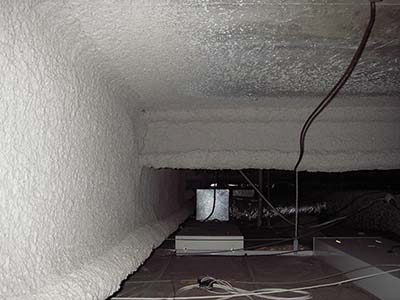Asbestos
Asbestos
If asbestos containing material is in good condition it poses little health risk. However, when asbestos containing products are disturbed by cutting, drilling, water blasting or similar activities, small fibres may be released into the air.
These fibres are harmful if inhaled and may lead to asbestos related diseases such as asbestosis, lung cancer or mesothelioma.
Around 4000 Australians die every year from asbestos related diseases, that’s double the road toll. Asbestos related diseases are preventable by following safe practices when working with asbestos.
You must always use a licensed asbestos professional to remove friable asbestos and when there is more than 10sqm of non-friable (bonded) asbestos. However due to the risks associated with disturbing asbestos, SafeWork NSW recommends you use a licensed asbestos professional to remove any amount of non-friable asbestos.
Online asbestos awareness and safety course
SafeWork NSW has launched an asbestos awareness and safety course about how to protect yourself when handling products containing asbestos.
This course will help you identify asbestos and hazardous activities that lead to asbestos exposure. You will learn about:
- the long-term impacts of exposure
- how to safely handle asbestos
- how to communicate about asbestos risks
- controls with an informed perspective.
This course is for:
- NSW construction tradespeople
- demolition workers
- renovators
- handypersons
- anyone who is likely to encounter asbestos on the job.
Completing this course will ensure employers meet their legal obligation to provide asbestos awareness training to workers who are likely to encounter asbestos on the job. Further training is required to do licensed asbestos removal work i.e. to remove more than 10sqm of non-friable asbestos or any amount of friable asbestos.
Register today at the TAFE NSW store website.
Who to contact
Contacts for various situations
Workers and workplaces
If you have a query relating to asbestos in the workplace or you are an asbestos worker.
Asbestos in the home
Contact your local council
Illegal dumping of asbestos
To report illegal dumping of asbestos contact the NSW Environment Protection Authority or 131555.
Asbestos disposal
For a list of approved facilities who accept asbestos waste contact the NSW Environment Protection Authority or 131 555.
Asbestos in a rented property
Contact your property manager to discuss the issue.
If you are unable to reach a resolution, contact your local council
Someone is removing asbestos near me
If the area where the asbestos is being removed has been secured to prevent unauthorised access, asbestos signage is in place and workers are wearing full personal protective equipment then the removal is unlikely to pose any risk to you. If you are still concerned:
Residential
If the removal is at a residential property, contact your local council
OR
Workplace
If the removal is at a workplace, contact SafeWork NSW
Asbestos in community facilities
Contact your local council
Find an asbestos professional
Click here for a list of licensed asbestos professionals
Asbestos professionals - who does what?
A non-friable asbestos removal licence is required to remove more than 10sqm of non-friable asbestos.
A friable asbestos removal licence is required to remove any amount of friable asbestos.
SafeWork NSW recommends that you contact a licensed asbestos professional to assess or remove any amount of asbestos.
Descriptions of various asbestos professionals
Competent person
A competent person is someone who has acquired through training or experience the knowledge and skills of relevant asbestos removal industry practice and holds the following:
- a certification in relation to the specified VET course for asbestos assessor work, or
- a tertiary qualification in occupational health and safety, occupational hygiene, science, building, construction or environmental health
Asbestos assessor
Asbestos assessor licenses are required to provide air monitoring and clearance certificates in relation to friable asbestos removal work.
Clearance certificates must be issued by independent asbestos assessors for all friable asbestos removal work before a site can be reoccupied.
For non-friable asbestos removal work, clearance certificates may be issued by either a competent person or an asbestos assessor.
Asbestos removal supervisor
For licensed asbestos removal work, there must be a nominated supervisor present whenever Class A (friable asbestos) removal work is carried out. A nominated supervisor must be present or readily available to attend the site when Class B (non-friable asbestos) removal work is being carried out.
What does it mean to be independent when issuing a clearance certificate?
A clearance inspection is required at the completion of all licensed asbestos removal work, prior to reoccupation.
They can only be undertaken by a person who is independent of the asbestos removal work and who has acquired the relevant training or experience to undertake the work.
Persons undertaking asbestos clearance inspections MUST ensure they are independent of the asbestos removal work which means:
- they did not undertake the work, and,
- they are not involved in the business or undertaking that carried out the work.
If there is potential for a perceived conflict of interest you should consider that they are not independent. For example if the person is a relative, friend or there is an ongoing working relationship then this would not be deemed independent.
What is asbestos and where to find it
Finding, identifying and recording asbestos
Types of asbestos
Friable asbestos
Friable asbestos is asbestos in a powder form or that can be crumbled, pulverised or reduced to a powder by hand pressure when dry.
Non-friable asbestos
Non-friable asbestos is material containing asbestos fibres reinforced with a bonding compound. It is also known as bonded asbestos and can be found in products such as asbestos cement sheeting commonly used in building materials between 1940’s to the late 1980’s.
Common locations of asbestos
If you’re renovating or working on a home or building built before the late 1980s, it may contain asbestos.
Asbestos materials were commonly used in flooring, kitchens, bathrooms, as well as roofs, ceilings, walls and more. There is no known safe minimum level of exposure.
Use the asbestos finder to see what products might contain asbestos and where they are commonly located.
If you think it’s asbestos, treat it like it is and call a licensed asbestos professional to help you assess it and remove it.
Asbestos sampling and testing
The only way to be certain that something contains asbestos is to have a sample tested in a laboratory. Treat all suspected asbestos as asbestos until test results confirm otherwise.
All asbestos testing should be done by a National Association of Testing Authorities (NATA) accredited facility. NATA accreditation is formal recognition that the facility produces reliable technical results.
A list of NATA accredited facilities is available on the NATA website.
It is strongly recommended that you use a licensed professional to collect samples of suspected asbestos for testing.
Asbestos registers and asbestos management plans
Asbestos register
If your workplace was built before 31 December 2003 or if asbestos has been identified at the workplace, you must keep a register that outlines:
- when the asbestos was found
- where it is located
- what type of asbestos it is
- what condition it is in.
You must also:
- make the register available to anyone likely to be exposed to asbestos,
- keep it up to date
- pass it on to anyone who takes over management or control of the workplace.
Asbestos management plan
If asbestos has been identified at your workplace, you must prepare and maintain an asbestos management plan, regardless if the asbestos is naturally occurring or manufactured.
Your plan must include:
- reference (or a link) to the asbestos register, and signage and labelling
- safe work procedures and control measures
- incident and emergency procedures
- consultation arrangements, responsibilities and training details of workers undertaking asbestos removal or asbestos related work.
You must review the plan at least every five years or when:
- requested by a health and safety representative (HSR)
- asbestos is removed, disturbed, sealed or enclosed.
The plan must be available to anyone involved in work at the workplace.
Photos of asbestos on site
Select a quick link for photos of asbestos hazards for different tradies.
Asbestos hazards for electricians
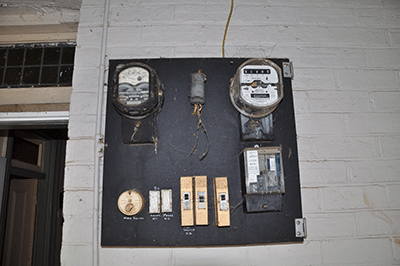
Electrical backing board
Spray insulation
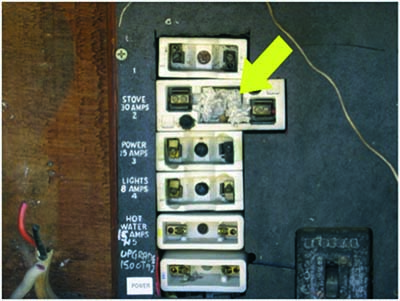
Fuse linings
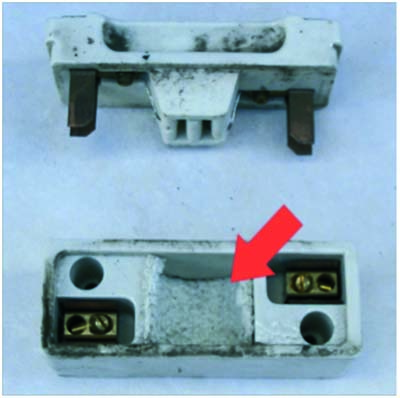
Fuse linings
Asbestos hazards for plumbers
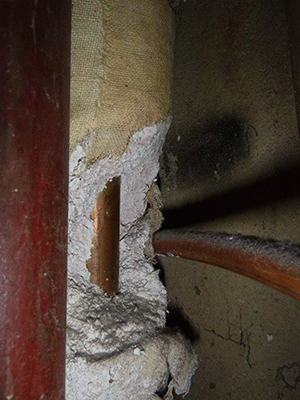
Pipe lagging
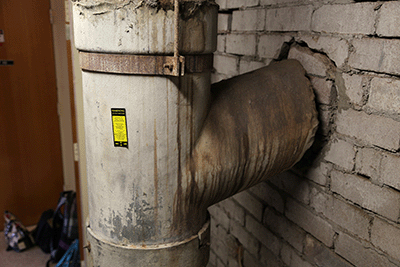
Cement pipes
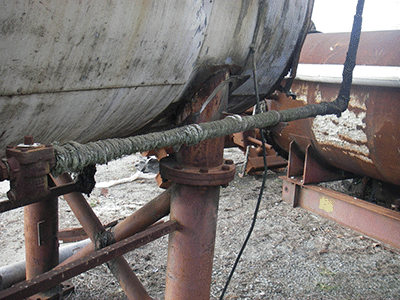
Rope insulation
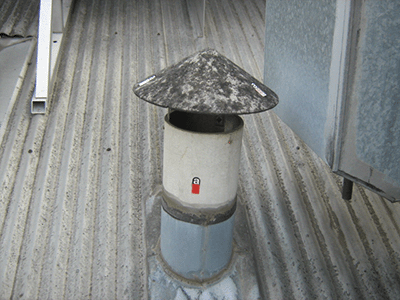
Sewer vents
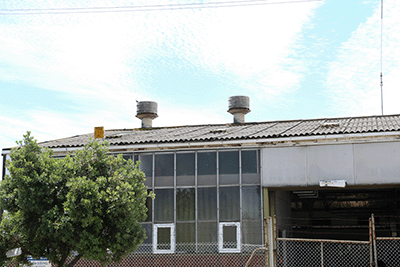
Flue pipes
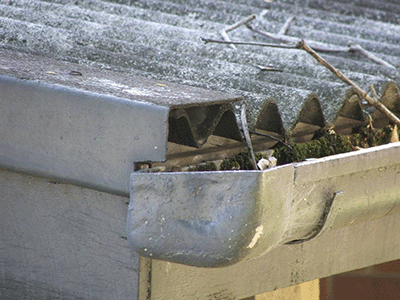
Gutters
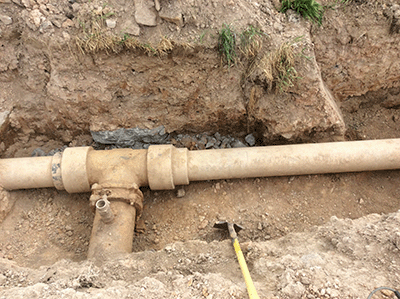
In-ground pipes
Asbestos hazards inside the home
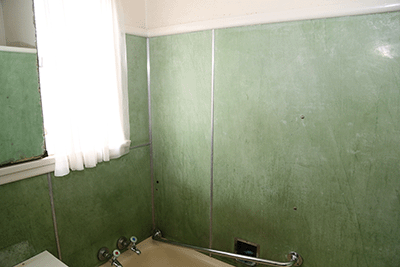
Tilux wall in bathroom
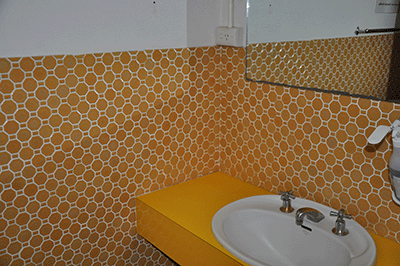
Wall sheeting behind tiles
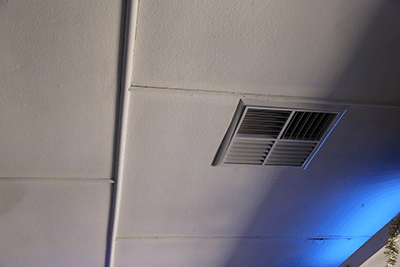
Ceiling
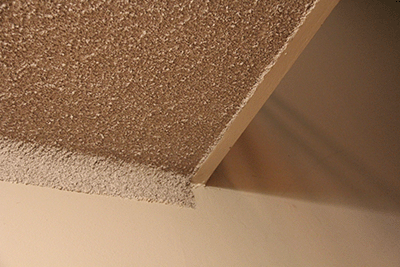
Vermiculite ceiling
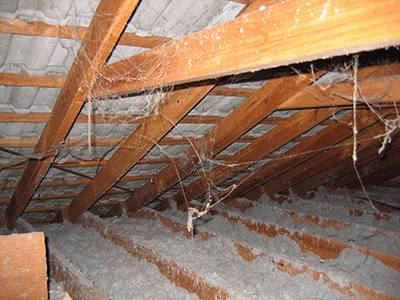
Loose-fill roof insulation
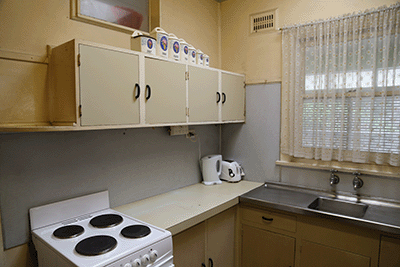
Wall sheeting in kitchen
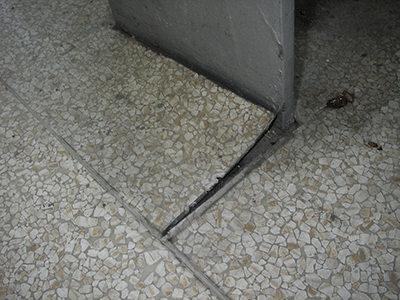
Vinyl floor tiles and adhesives
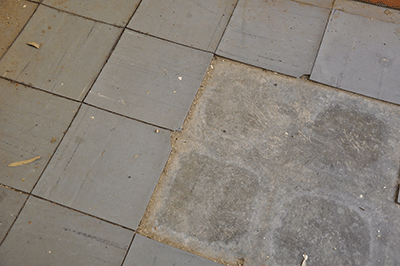
Vinyl floor tiles and adhesives
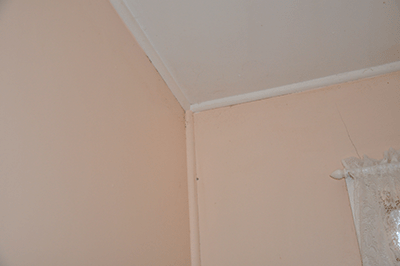
Walls, ceiling and moldings
Asbestos hazards outside the home
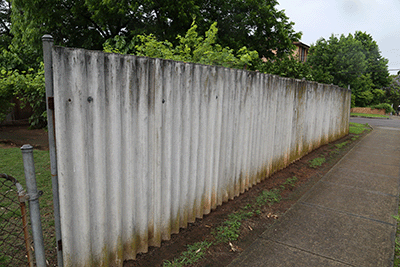
'Super 6' fencing
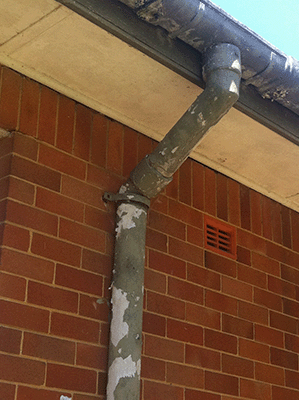
Gutter, downpipes, eaves and cover strips
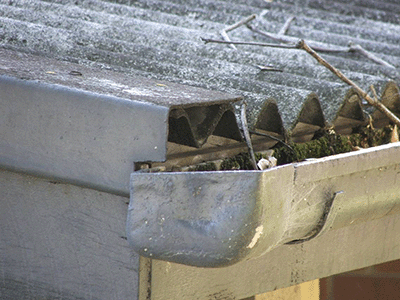
Flashing, roofing and guttering
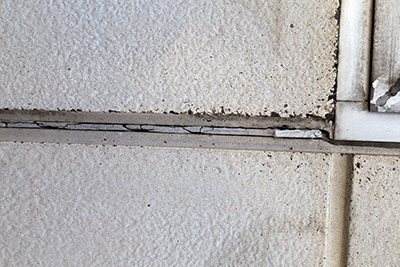
Mastics
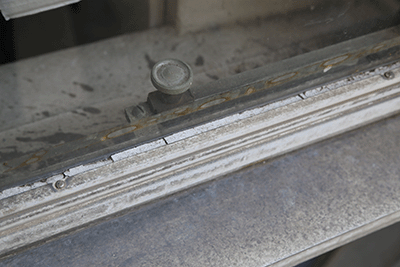
Window putty
Asbestos houses
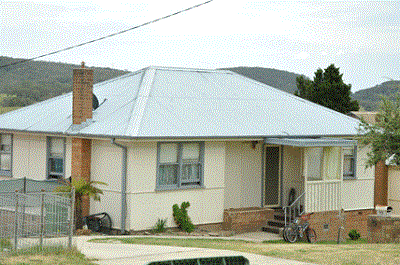
Wall sheeting, gutters, cover strips
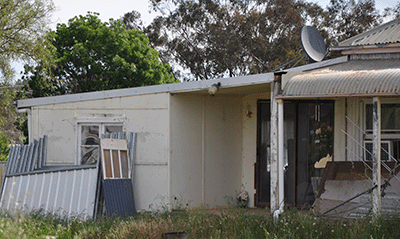
Wall sheeting, cover strips, flashings
Asbestos roofing
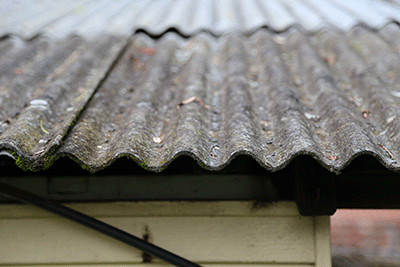
Super 6 roof
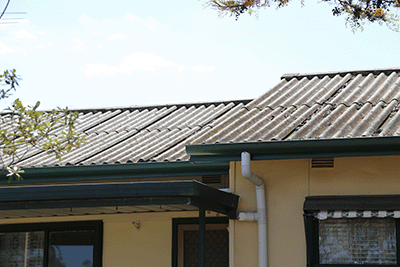
Super 6 roof and sheeting
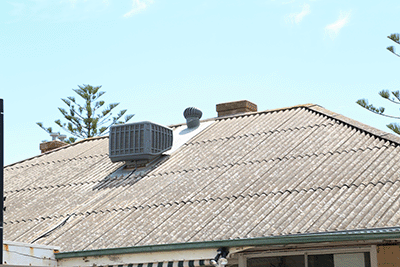
Super 6 roof and flashings
Fire door
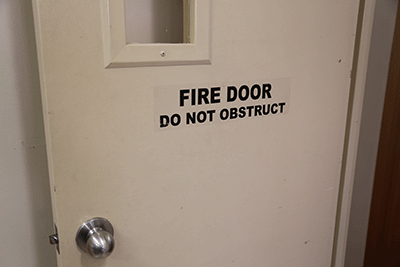
Fire Door
Naturally Occurring Asbestos (NOA)
Asbestos in its natural form can be blue (crocidolite), brown (amosite), green (anthophyllite tremolite and actinolite) or white (chrysotile, tremolite and actinolite). Known as Naturally Occurring Asbestos or NOA, it’s found in some rocks, sediments and in soils in various regions of NSW and is not easily identified.
If covered and left undisturbed, NOA is not considered dangerous. However, if disturbed and microscopic fibres become airborne or settle on clothing or equipment and can be inhaled, NOA can cause incurable diseases including malignant mesothelioma, lung cancer and asbestosis.
Less than one percent of land in NSW is believed to contain NOA within 10 metres of the ground’s surface. NOA veins are scattered around the state, mostly west of the Great Dividing Range.
Map of where NOA is located in NSW
Only testing by a National Association of Testing Authorities (NATA) accredited laboratory, of a sample collected by a competent person, can confirm the presence of asbestos in any workplace including in building materials or in its natural forms in the environment.
Any work or activities that could disturb affected earth, rocks, and soils creates a potential risk. This is because disturbing NOA can release asbestos fibres into the air, which could be inhaled or contaminate clothing and equipment.
A suite of guidance material has been developed to assist those in areas where NOA may be present – see links below
Legacy asbestos
James Hardie Legacy Sites
The Environment Protection Authority is working with the City of Parramatta Council and other state government authorities including SafeWork NSW, to re-assess the risk of contamination at properties around the Parramatta local government area where James Hardie may have disposed of asbestos waste materials.
For more information visit James Hardie asbestos waste contamination on the NSW EPA website.
Loose-fill asbestos
Loose-fill asbestos was sold as ceiling insulation In the 1960s and 1970s by a company trading as Mr Fluffy.
While most properties impacted were located in the ACT, some properties in NSW were identified as containing this type of insulation.
In December 2014, the NSW Government offered a package for affected home-owners in response to the issue of loose-fill asbestos insulation in NSW homes.
For more information visit the Loose-fill asbestos insulation page on the NSW Fair Trading website.
Health
If you employ workers who are at risk of being exposed to asbestos, you are required by law to advise them about the health risks of exposure.
Diseases related to asbestos
Inhalation of asbestos fibres may lead to diseases such as asbestosis, mesothelioma and lung cancer. Employers must ensure their workers follow safe processes when working with asbestos to prevent exposure.
If asbestos is disturbed it can release dangerous fine particles of dust containing asbestos fibres which can cause illness when inhaled.
Asbestosis
Asbestosis is a chronic chest disease caused by inhalation of high concentrations of asbestos fibres. The condition can develop 10 to 20 years after initial exposure. Asbestos fibres initially damage cell membranes in the lungs and, as a result, the lung tissue becomes hardened and scars.
Symptoms of asbestosis include shortness of breath after exercise, persistent coughing, chest pain, phlegm, lung infections, pulmonary hypertension and heart failure.
Early abnormalities of asbestosis are difficult to detect in a lung X-ray, however, as the disease progresses the X-ray is characterised by a cloudy, ground glass appearance.
Lung cancer
Lung cancer of the bronchial tubes, lungs and alveoli can develop after exposure to asbestos. Those who have been exposed to asbestos and who have smoked run a much greater risk of getting lung cancer.
Symptoms of lung cancer include an irritative cough with increasing sputum, followed by blood-tinged sputum, coughing up blood, chest pains and chest infections.
Mesothelioma
Mesothelioma is a cancer of the lung lining. It can result from low-level exposure to asbestos and can take 30 to 45 years to develop after initial exposure. It is an aggressive and painful cancer, and sufferers rarely live longer than 12 to 18 months.
A dull, aching chest pain and shortness of breath are the early symptoms, followed by abdominal pain, abdominal swelling and loss of weight.
Pleural disease
Inflammation and irritation of outer lining of the lung, the pleura. The pleura stiffens and thickens widely (diffused thickening) or in patches (plaques) and can fill with fluid. This thickening can restrict breathing.
Asbestos exposure
If you think you may have been exposed to asbestos do the following:
- Stop work immediately
- Immediately report the incident to your manager
- Minimise disturbance of the material and area
- Inform workers to prevent access until the hazard has been contained
- Set up an exclusion zone using barricades and warning signs restricting access to the contaminated area
- Consult a licensed asbestos assessor to provide immediate advice on making the area safe. Advice on decontamination and disposal of clothing (as asbestos waste) should also be obtained
- Contact SafeWork NSW on 13 10 50 to report the incident.
- Contact a licensed asbestos professional to undertake removal works at contaminated area
- Health monitoring must be undertaken or supervised by a registered medical practitioner experienced in health monitoring as soon as practical after the exposure.
- Register your details on the National Asbestos Exposure Register.
Notification of an asbestosis or mesothelioma diagnosis
As of 1 January 2021 all workplace related diagnoses of asbestosis and mesothelioma must be notified by the medical practitioner to NSW Health who are required to disclose the information to SafeWork NSW. Further information can be found on the NSW Health website under Disease Notification.
Legislation
Legislation related to asbestos
Asbestos regulation
Employers of workers who may be exposed to asbestos on the job or those removing asbestos must adhere to the rules and regulations as stipulated in the:
Codes of Practice
The Codes of practice listed below have been developed by Safe Work Australia to assist PCBU’s to achieve compliance with the Work Health and Safety Act and the Work Health and Safety Regulation.
- Code of Practice – How to manage and control asbestos in the workplace
- Code of Practice – How to safely remove asbestos
Importing and exporting asbestos
Importing and exporting asbestos is prohibited under Australian law. The Asbestos Safety and Eradiation Agency (ASEA) is responsible for administering the import and export permission process for the Commonwealth Minister with responsibility for the Work Health and Safety Act 2011.
For more information see Asbestos Safety and Eradication Agency website
Disposal
Disposal of asbestos waste is governed under the Protection of the Environment Operations Act 1997 which falls under the responsibility of the NSW Environment Protection Authority.
Asbestos workers and removalists
There are specific laws about working with asbestos. Below we summarise some of those laws.
Licensed asbestos removalists
Learn about working as a licensed asbestos removalist (including safe removal and disposal of asbestos and personal protective equipment) and how to get licensed.
Licensed asbestos assessors
Learn about working as a licensed asbestos assessor (including air monitoring) and how to get licensed.
Asbestos awareness training
Less than 10sqm of asbestos removal
Asbestos awareness training must be provided to workers who are who are carrying out asbestos removal work of less than 10m2 and/or workers who are at risk of being exposed to asbestos while on the job i.e. electricians, plumbers, bathroom and kitchen renovators
The training must be relevant to the task and must cover:
- asbestos identification
- safe handling of asbestos
- suitable control measures
Asbestos awareness and safety course
SafeWork NSW has launched an online asbestos awareness and safety course which will help you meet your training obligations and provide workers the skills they need to stay safe when working with asbestos.
Register today at the TAFE NSW store website.
Greater than 10sqm of asbestos removal or friable asbestos removal
To remove more than 10sqm of non-friable asbestos or any amount of friable asbestos workers must complete the specified VET course before carrying out asbestos work.
If you're a worker who supervises asbestos removal, there is additional training you need to do. Learn about training requirements for a:
Fit testing and personal protective equipment (PPE)
The PPE you will need prior to commencing asbestos removal is listed below and should be worn in this order:
- Disposable asbestos coveralls rated type 5, category 3 (allow one or two sizes larger for ease of fit)
- Steel – capped rubber-soled work shoes or gumboots with no laces or
- Disposable overshoes that have an anti-slip sole for placement over work shoes
- Single use disposable nitrile or latex gloves (nitrile is preferred as they are stronger)
- Face Mask
- Non- Friable asbestos work - P2 class, negative pressure respirator
- Friable asbestos work – P3 class, full face respirator
- Protective eye-wear (if not wearing a full face mask)
You must get fit tested to ensure your mask fits correctly with proper seals to prevent exposure to asbestos.
When wearing respiratory protection, you need to be clean shaven to ensure a proper seal between your face and mask to protect you from breathing in asbestos fibres.
Asbestos workers with beards, stubble or facial hair, should use a continuous flow positive pressure respirator.
For more information watch our PPE video and fit testing your respirator video.
Health monitoring
Employers are required by law to provide health monitoring to workers who are at risk of being exposed to asbestos while on the job, prior to commencing asbestos removal work or ongoing asbestos related work. This includes licensed asbestos removalists and assessors who are wearing full personal protective equipment.
Health monitoring should also be provided to workers at regular intervals (at least once every two years) after the worker commences asbestos-related work where there is a risk of exposure to asbestos.
A copy of the health monitoring report must be provided to SafeWork NSW where the report contains:
- advice that a worker may have contracted a disease, injury or illness, or
- any recommendations that remedial measures be taken
Notifications of an adverse health monitoring report should be made using the “Notification of an adverse health monitoring report”.
From 1 July 2020, a penalty applies for failure by a business (PCBU) to notify SafeWork NSW of an adverse health monitoring report.
Trades
How to protect yourself
SafeWork NSW recommends that you should always engage a licensed asbestos professional if there is a chance that asbestos may be present. If you are working with asbestos, you need to do the following:
- have everything you need before you commence the job
- wear Personal protective equipment
- follow the asbestos removal process as outlined in the SafeWork Australia Code of Practice - How to safely remove asbestos
- if drilling into asbestos use an LEV or a Class H HEPA vacuum
- wrap and dispose of asbestos according to guidelines SafeWork Australia Code of Practice (how to safely remove asbestos)
- decontaminate the area and yourself
- dispose of asbestos at a waste disposal facility which is licensed to accept asbestos waste.
Find your nearest disposal site that is licensed to handle asbestos.
Prohibited equipment
The use of certain tools and equipment on asbestos or asbestos containing material is prohibited.
The following should never be used:
- high-pressure water spray, jets, power or similar tools and instruments
- compressed air.
See full video on the dangers of pressure cleaning asbestos roofs
See condensed video on the dangers of pressure cleaning asbestos roofs
Controlled use allowed
High speed power tools such as angle-grinders, sanders, saws and drills or any other tools or equipment, such as brooms, that can cause the release of asbestos fibres into the air can only be used if:
- the tool/equipment is enclosed during its use; or
- the tool/equipment is designed to capture or suppress airborne asbestos and is used in accordance with its design; or
- the tool/equipment is used in a way that is designed to capture or suppress airborne asbestos safely.
Decontamination
All tools and equipment used during the asbestos removal process must be decontaminated before being removed from the asbestos removal area. Tools and equipment that can't be decontaminated should be double bagged and sealed in asbestos waste bags before removal.
The bags containing the tools or equipment must remain sealed until decontamination.
More information can be found in the How to safely remove asbestos – Code of Practice.
Unlicensed removal (less than 10sqm non-friable asbestos)
Although unlicensed removal of asbestos is permitted in certain circumstances, we always recommend engaging a licensed asbestos removalist to remove any amount of asbestos.
When can I remove asbestos?
Under the Work Health and Safety Regulations 2017, an employer or self-employed person can conduct a limited amount of asbestos removal work or asbestos related work without a licence involving:
- the removal of non-friable asbestos-containing material if the area of asbestos-containing material to be removed does not exceed 10 square metres in total.
Obligations
If you do decide to remove less than 10sqm of asbestos yourself then before you start work you must:
- Read and follow the Code of Practice – How to safely remove asbestos
- Be aware and advise any workers of the health risks associated with exposure to asbestos
- Undertake and provide any workers with asbestos awareness training
- Undertake and provide health monitoring to any workers if work with asbestos is likely to be ongoing
If you are not willing or able to commit to any of the above obligations then you should engage a licensed asbestos professional.
See our video section under Resources for important asbestos messages.
Property owners and home renovators
Information for property owners and home renovators can be found at www.asbestos.nsw.gov.au
Training
Learn about applying for an asbestos removalist or assessor licence and the training and experience you need.
SafeWork approved RTOs delivering asbestos training
Only registered training organisations (RTOs) with SafeWork approval can deliver asbestos removal, assessor or supervisor training in NSW. Asbestos licence applications will only be considered if training has been undertaken with a SafeWork approved RTO.
| RTO details | Approved for |
|---|---|
Advance Consulting & Training Phone: (02) 9635 4444 | Class B |
| Alertforce 16/13-15 Wollongong Road Arncliffe NSW 2205 Phone: 1800 900 222 Email: service@alertforce.com.au Website: www.alertforce.com.au Note: Alertforce is approved to deliver Class B, non-friable asbestos removal training courses on client sites. |
Class A Class B Supervisor Assessor |
Career Skills Australia Pty Ltd Phone: (02) 9061 5331 |
Class B Supervisor |
Combined Training and Consulting Pty Ltd Unit 6/116 Russell Street Unit 3/22 Reliance Drive Phone: (02) 9979 7888 Note: Combined Training and Consulting is approved to deliver asbestos training courses on-site, statewide. | Class B |
Design Learning Inspection Pty Ltd Phone: (02) 8599 2220 | Class A Class B Supervisor Assessor |
Elbon Consulting Phone: 1300 884 978 | Class B |
Health and Safety Advisory Service Pty Ltd Phone: (02) 4739 9748 | Class A Class B Supervisor Assessor |
Master Builders Association 2 Boeing Avenue Level 1/165 Lambton Street 5 Burbank Place 1/18 Jambali Road 66 Auburn Street Unit 1/171 Princes Highway Phone: (02) 8586 3588 | Class B Supervisor |
| Class A |
Newcastle Rescue and Consultancy Pty Ltd Phone: 1300 356 686 |
Class A Class B Supervisor |
Pinnacle Height Safety Pty Ltd Pinnacle Height Safety is approved to deliver Class B, non-friable asbestos removal training courses on client sites. |
Class A Class B Supervisor |
RTO Safety Training Pty Ltd Phone: (02) 9892 3370 |
Class A Class B Supervisor |
Safety Training Academy |
Class B Supervisor |
TAFE NSW Multiple locations: TAFE NSW Broken Hill TAFE NSW Dubbo Note: TAFE NSW Dubbo is approved to deliver Class B non-friable asbestos removal and asbestos supervisor training courses on client sites. TAFE NSW Newcastle Note: TAFE NSW Newcastle (Tighes Hill) is approved to deliver Class B non-friable asbestos removal and asbestos supervisor training courses on client sites. TAFE NSW Wagga Wagga Note: TAFE NSW Wagga Wagga is approved to deliver Class B non-friable asbestos removal training courses on client sites. |
Class B Supervisor |
Training Aid Australia Pty Ltd Phone: 1300 663 350 | Class A |
Trayn Phone: (02) 9618 0334 |
Class B Supervisor |
| Wiradjuri Demolitions Civil Pty Ltd (Delivered on client sites state-wide by Viable Training Pty Ltd) Phone: 0428 187 515 Email: wiradjuridemolitions@gmail.com | Class A |
Employer training obligations
Businesses, employers and other PCBUs have a general duty to provide information, training and instructions to their workers. Asbestos removal work has specific training and licensing requirements.
If you are an employer or business (or other PCBU) who carries out removal work (or may have contact with asbestos), you must ensure that you and you workers complete asbestos awareness training.
If loose fill asbestos insulation or naturally occurring asbestos is likely to be found at a workplace, you must provide training in how to identify and manage the associated risks and hazards.
You must keep training records while the worker is carrying out the work and for five years after the worker finished. Training records must be readily accessible at the asbestos removal area.
Asbestos awareness training (less than 10sqm non-friable asbestos removal)
Less than 10sqm of non-friable asbestos removal
Asbestos awareness training must be provided to workers who are who are carrying out non-friable asbestos removal work of less than 10m2 and/or workers who are at risk of being exposed to asbestos while on the job, for example, electricians, plumbers, bathroom and kitchen renovators.
The training must be relevant to the task and must cover:
- asbestos identification
- safe handling of asbestos
- suitable control measures.
Completion of SafeWork NSW's online Asbestos Awareness and Safety Course will satisfy employer's legal obligation to provide asbestos awareness training to workers who are likely to encounter asbestos on the job.
Information for RTOs
Information for RTOs to deliver asbestos removal training in NSW can be found on How to become an approved RTO to deliver asbestos training.
Resources
A wide range of government agencies provide resources and information for the safe management and monitoring of asbestos. See below for links to guidance material, asbestos networks and videos.
Guidance material
Working with asbestos
- Asbestos and the dangers of pressure cleaning roofs
- Asbestos in natural stone products
- Asbestos removal PCBU checklist (PDF, 184.28 KB)
- Asbestos assessor checklist (PDF, 151.49 KB)
- Asbestos removal control plan for Class B (non-friable) removal work - template (PDF, 205.28 KB)
- Clearance Inspections and Clearance Certificates - webinar
- Commercial Properties
- Dust in Construction poster (PDF, 443.69 KB)
- Dust Strategy 2020-2022 released by the NSW Government to help reduce the impact of dust diseases on workers.
- How to manage and control asbestos in the workplace: Code of practice (PDF, 1650.55 KB)
- How to safely remove asbestos code of practice (PDF, 2770.66 KB)
- Information for licensed asbestos removalists
- Managing asbestos in or on soil guide (PDF, 309.32 KB)
- Managing risks of exposure to asbestos
- Management of asbestos in recycled construction and demolition waste guide (PDF, 1271.84 KB)
- Model asbestos policy
- Naturally occurring asbestos fact sheet
- Naturally occurring asbestos guidance material
- Non-friable asbestos clearance certificate - no air monitoring
Translated resources
Download the Think twice about Asbestos fact sheet in the following languages
- Arabic (PDF, 259.96 KB)
- Assyrian (PDF, 3521.44 KB)
- Simplified Chinese (PDF, 1249.18 KB)
- Traditional Chinese (PDF, 1235.49 KB)
- Dari (PDF, 208.14 KB)
- Khmer (PDF, 249.52 KB)
- Korean (PDF, 1350.93 KB)
- Punjabi (PDF, 1161.07 KB)
- Vietnamese (PDF, 1148.97 KB)
Download posters and flyers about the dangers of pressure cleaning on asbestos roofs in the following languages
- Arabic - flyer and poster
- Assyrian - flyer and poster
- Traditional Chinese - flyer and poster
- Simplified Chinese - flyer and poster
- Dari - flyer and poster
- Khmer -flyer and poster
- Korean - flyer and poster
- Punjabi - flyer and poster
- Vietnamese - flyer and poster
Safety alerts
| Date of issue | Alert issued |
|---|---|
| 19 June 2023 | Serpentine Rough Gemstones - product recall |
| 20 Dec 2019 | Bunsen Burner gauze mats |
| 24 Oct 2019 | Pool Hinge Gaskets |
| 20 Mar 2019 | Bee Smokers |
SafeWork NSW position papers
- Removal of asbestos waste from sites - SafeWork NSW position
- Cladding over asbestos containing materials – SafeWork NSW position
- Transporting structures containing asbestos - SafeWork NSW position
Asbestos after fires
Property hazards after a bushfire
Asbestos after floods
For home owners, businesses and volunteers involved in the clean-up of buildings damaged by floods and storms, see how to clean and/or remove asbestos waste after floods and storms.
Health
This is the first of five videos in a series, showing tradies how to manage asbestos safely on the job. This video covers the hazards and risks associated with asbestos and includes images of many asbestos containing materials.
This is the second of five videos in a series showing tradies how to manage asbestos safely on the job. This video demonstrates how to set up an asbestos work area if you need to work with or remove less than 10sqm of non-friable asbestos.
This is the third of five videos in a series, showing tradies how to manage asbestos safely on the job. This video demonstrates the use of correct personal protective equipment needed, when working with or removing less than 10sqm of non-friable asbestos.
This is the fourth of five videos in a series, showing tradies how to manage asbestos safely on the job. This video demonstrates how to safely drill into asbestos containing materials.
This is the final (fifth) video in a series of five, showing tradies how to manage asbestos safely on the job. This video demonstrates how to correctly decontaminate an asbestos work area when working with or removing less than 10sqm of non-friable asbestos.
Lindsay Wall was exposed to asbestos as a young tradie and lost his battle with mesothelioma, an asbestos-related disease in November 2019. Remember before you start on the job, asbestos lurks in more places than you think.
Cladding over asbestos sheeting can cause significant damage to asbestos containing material. Watch our safety alert for more advice
Never use high-pressure water or compressed air on asbestos products and be careful when working on asbestos roofs – they are brittle and you can easily fall through. Watch our safety alert for more advice.
To ensure respirators are protecting you and your workers from breathing in asbestos fibres you must be fit tested. This video tells you about the importance of fit testing and how to go about it.
SafeWork NSW Inspector Jason Wall found a number of asbestos containing products which may not be obvious to most people, in this old residential home prior to it being demolished.
How to take a sample of suspected asbestos containing material to confirm the presence of asbestos.
How to remove asbestos sheeting safely using different tools.
